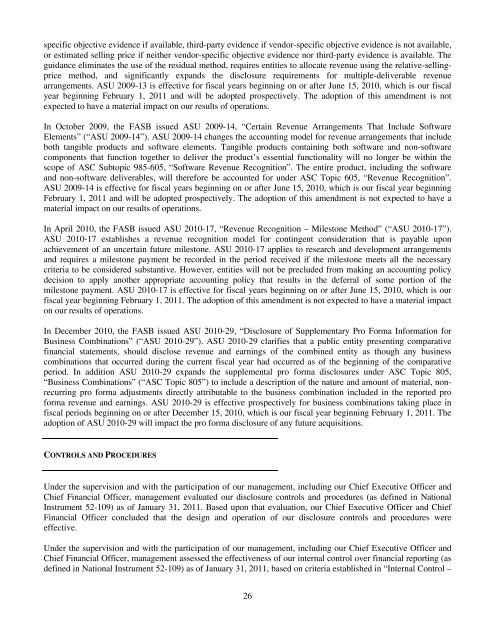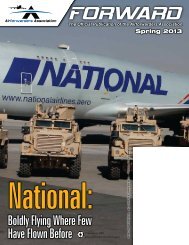THE DESCARTES SYSTEMS GROUP INC.
THE DESCARTES SYSTEMS GROUP INC.
THE DESCARTES SYSTEMS GROUP INC.
You also want an ePaper? Increase the reach of your titles
YUMPU automatically turns print PDFs into web optimized ePapers that Google loves.
specific objective evidence if available, third-party evidence if vendor-specific objective evidence is not available,<br />
or estimated selling price if neither vendor-specific objective evidence nor third-party evidence is available. The<br />
guidance eliminates the use of the residual method, requires entities to allocate revenue using the relative-sellingprice<br />
method, and significantly expands the disclosure requirements for multiple-deliverable revenue<br />
arrangements. ASU 2009-13 is effective for fiscal years beginning on or after June 15, 2010, which is our fiscal<br />
year beginning February 1, 2011 and will be adopted prospectively. The adoption of this amendment is not<br />
expected to have a material impact on our results of operations.<br />
In October 2009, the FASB issued ASU 2009-14, “Certain Revenue Arrangements That Include Software<br />
Elements” (“ASU 2009-14”). ASU 2009-14 changes the accounting model for revenue arrangements that include<br />
both tangible products and software elements. Tangible products containing both software and non-software<br />
components that function together to deliver the product’s essential functionality will no longer be within the<br />
scope of ASC Subtopic 985-605, “Software Revenue Recognition”. The entire product, including the software<br />
and non-software deliverables, will therefore be accounted for under ASC Topic 605, “Revenue Recognition”.<br />
ASU 2009-14 is effective for fiscal years beginning on or after June 15, 2010, which is our fiscal year beginning<br />
February 1, 2011 and will be adopted prospectively. The adoption of this amendment is not expected to have a<br />
material impact on our results of operations.<br />
In April 2010, the FASB issued ASU 2010-17, “Revenue Recognition – Milestone Method” (“ASU 2010-17”).<br />
ASU 2010-17 establishes a revenue recognition model for contingent consideration that is payable upon<br />
achievement of an uncertain future milestone. ASU 2010-17 applies to research and development arrangements<br />
and requires a milestone payment be recorded in the period received if the milestone meets all the necessary<br />
criteria to be considered substantive. However, entities will not be precluded from making an accounting policy<br />
decision to apply another appropriate accounting policy that results in the deferral of some portion of the<br />
milestone payment. ASU 2010-17 is effective for fiscal years beginning on or after June 15, 2010, which is our<br />
fiscal year beginning February 1, 2011. The adoption of this amendment is not expected to have a material impact<br />
on our results of operations.<br />
In December 2010, the FASB issued ASU 2010-29, “Disclosure of Supplementary Pro Forma Information for<br />
Business Combinations” (“ASU 2010-29”). ASU 2010-29 clarifies that a public entity presenting comparative<br />
financial statements, should disclose revenue and earnings of the combined entity as though any business<br />
combinations that occurred during the current fiscal year had occurred as of the beginning of the comparative<br />
period. In addition ASU 2010-29 expands the supplemental pro forma disclosures under ASC Topic 805,<br />
“Business Combinations” (“ASC Topic 805”) to include a description of the nature and amount of material, nonrecurring<br />
pro forma adjustments directly attributable to the business combination included in the reported pro<br />
forma revenue and earnings. ASU 2010-29 is effective prospectively for business combinations taking place in<br />
fiscal periods beginning on or after December 15, 2010, which is our fiscal year beginning February 1, 2011. The<br />
adoption of ASU 2010-29 will impact the pro forma disclosure of any future acquisitions.<br />
CONTROLS AND PROCEDURES<br />
Under the supervision and with the participation of our management, including our Chief Executive Officer and<br />
Chief Financial Officer, management evaluated our disclosure controls and procedures (as defined in National<br />
Instrument 52-109) as of January 31, 2011. Based upon that evaluation, our Chief Executive Officer and Chief<br />
Financial Officer concluded that the design and operation of our disclosure controls and procedures were<br />
effective.<br />
Under the supervision and with the participation of our management, including our Chief Executive Officer and<br />
Chief Financial Officer, management assessed the effectiveness of our internal control over financial reporting (as<br />
defined in National Instrument 52-109) as of January 31, 2011, based on criteria established in “Internal Control –<br />
26



